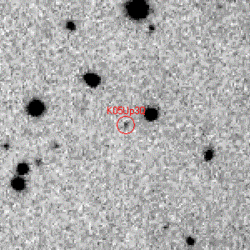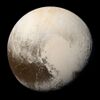Astronomy:(202421) 2005 UQ513
 | |
| Discovery[3] | |
|---|---|
| Discovered by | M. E. Brown D. L. Rabinowitz C. A. Trujillo |
| Discovery date | 21 October 2005[2] |
| Designations | |
| (202421) 2005 UQ513 | |
| Minor planet category | Cubewano (MPC)[4] ScatExt (DES)[5] |
| Orbital characteristics[2][7] | |
| Epoch 13 January 2016 (JD 2457400.5) | |
| Uncertainty parameter 3 | |
| Observation arc | 8474 days (23.20 yr) |
| Earliest precovery date | 15 September 1990 |
| |{{{apsis}}}|helion}} | 49.689 astronomical unit|AU (7.4334 Tm) (Q) |
| |{{{apsis}}}|helion}} | 36.713 AU (5.4922 Tm) (q) |
| 43.201 AU (6.4628 Tm) (a) | |
| Eccentricity | 0.15018 (e) |
| Orbital period | 283.95 yr (103713 d) |
| Mean anomaly | 223.93° (M) |
| Mean motion | 0° 0m 12.496s / day (n) |
| Inclination | 25.7315° (i) |
| Longitude of ascending node | 307.8679° (Ω) |
| |{{{apsis}}}|helion}} | ≈ 30 July 2123[6] ±3 days |
| 221.89° (ω) | |
| Earth MOID | 35.763 AU (5.3501 Tm) |
| Jupiter MOID | 31.568 AU (4.7225 Tm) |
| TJupiter | 5.253 |
| Physical characteristics | |
| Dimensions | 498+63 −75 km[8] |
| Rotation period | 7.03 h (0.293 d) |
| Sidereal rotation period | 7.03 hr?[2] |
| Geometric albedo | 0.31+0.12 −0.065[8] |
| Apparent magnitude | 20.8 [9] |
| Absolute magnitude (H) | 3.97 [2] |
(202421) 2005 UQ513 (provisional designation 2005 UQ513) is a cubewano with an absolute magnitude of 3.97.[2] Its spectrum has a weak signature of absorption by water ice.[10][11] Like Quaoar, it has a very red spectrum,[12][13] which indicates that its surface probably contains many complex, processed organic molecules.[12] Its light curve shows variations of Δm=0.3 mag, but no period has been determined.[13]
Classification
2005 UQ513 has a perihelion of 37.3 AU.[2] The Minor Planet Center (MPC) classifies it as a cubewano[4] while the Deep Ecliptic Survey (DES) classifies it as ScatExt (scattered-extended).[5] Although dynamically it would have been a good candidate to be a member of the Haumea collisional family, given its red spectrum, it is not.[12][13]
Distance
As of December 2018, it is currently 48.0 AU from the Sun.[9] It will come to perihelion in 2123.[6]
It has been observed 194 times over 14 oppositions with precovery images back to 1990.[2]
See also
- List of gravitationally rounded objects of the Solar System
References
- ↑ Lowe, Andrew. "(202421) 2005 UQ513 Precovery Images". http://andrew-lowe.ca/2005uq513.htm.
- ↑ 2.0 2.1 2.2 2.3 2.4 2.5 2.6 "JPL Small-Body Database Browser: (2005 UQ513)". https://ssd.jpl.nasa.gov/sbdb.cgi?sstr=2005UQ513.
- ↑ Brown, M.; Trujillo, C.; Rabinowitz, D.; Marsden, B. G. (2007). "2003 UY413, 2003 UZ413, 2004 NT33, 2005 CA79, 2005 CB79, 2005 UQ513". Minor Planet Electronic Circulars 2007-R02: R02. Bibcode: 2007MPEC....R...02B.
- ↑ 4.0 4.1 "MPEC 2010-S44 : DISTANT MINOR PLANETS (2010 OCT. 11.0 TT)". IAU Minor Planet Center. 2010-09-25. http://minorplanetcenter.org/mpec/K10/K10S44.html.
- ↑ 5.0 5.1 Marc W. Buie. "Orbit Fit and Astrometric record for 202421". SwRI (Space Science Department). http://www.boulder.swri.edu/~buie/kbo/astrom/202421.html.
- ↑ 6.0 6.1 JPL Horizons Observer Location: @sun (Perihelion occurs when deldot changes from negative to positive. Uncertainty in time of perihelion is 3-sigma.)
- ↑ "AstDyS (202421) 2005UQ513 Orbital information". Department of Mathematics, University of Pisa, Italy. https://newton.spacedys.com/astdys/index.php?pc=1.1.1&n=2005UQ513.
- ↑ 8.0 8.1 TNOs are Cool: A survey of the trans-Neptunian region. X. Analysis of classical Kuiper belt objects from Herschel* and Spitzer observations p. 18 arXiv:1403.6309
- ↑ 9.0 9.1 "AstDyS (202421) 2005UQ513 Ephemerides". Department of Mathematics, University of Pisa, Italy. https://newton.spacedys.com/astdys/index.php?pc=1.1.3.0&n=2005UQ513.
- ↑ Ragozzine, D.; Brown, M. E. (2007). "Candidate Members and Age Estimate of the Family of Kuiper Belt Object 2003 EL61". The Astronomical Journal 134 (6): 2160–2167. doi:10.1086/522334. Bibcode: 2007AJ....134.2160R. https://iopscience.iop.org/article/10.1086/522334/pdf. Retrieved 2009-12-05.
- ↑ Trujillo, C. A., Sheppard, S. S., & Schaller E. L. (2011). A Photometric System for Detection of Water and Methane Ices on Kuiper Belt Objects arXiv:1102.1971
- ↑ 12.0 12.1 12.2 Pinilla-Alonso, N., Licandro, J., & Lorenzi, V. (2008). Visible spectroscopy in the neighborhood of 2003 EL61 (Haumea) arXiv:0807.2670
- ↑ 13.0 13.1 13.2 Snodgrass, C., Carry, B., Dumas, C., & Hainaut, O. (2009). Characterisation of candidate members of (136108) Haumea’s family arXiv:0912.3171
External links
 |



